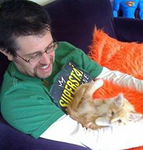Guillermo del Toro On Frankenstein And At The Mountains Of Madness
None
New Yorker article reveals some tantalising titbits about the director’s future projects

Some intriguing details about two in-progress projects from director Guillermo del Toro have come to light in an extensive feature on The New Yorker website.
Article writer Dale Zalewski has seen a number of designs for films such as the Lovecraft adaptation At The Mountains Of Madness and Frankenstein, neither of which have been given the official greenlight yet, but which del Toro has been beavering away on for the last couple of years.
Of a maquette of del Toro’s vision for Frankenstein’s monster he writes: “In accordance with Mary Shelley’s description the head appeared to have been stolen from a cadaver: there was exposed sinew around the jaw, and the cheekbones looked ready to poke through the scrim of flesh. Most appallingly, the Creature lacked a nose; a single bridge bone protruded over an oval breathing hole. Torres had been etching deep furrows into the Creature’s forehead, and shaved bits of clay were scattered on his desk, like clippings on a barbershop floor.”
Then he describes the look of the main creatures from At The Mountains Of Madness : “The Shoggoths had a racecar sheen. ‘They are pristine,’ [del Toro] said. ‘They are functional. They are not asymmetric. Symmetry is efficiency. And these guys need to be efficient.’ He wasn’t sure yet if the Shoggoth palette should be ‘pearlescent’ or ‘circulatory’ – reds and blues. Since the Shoggoths could mutate into anything, there was no fixed silhouette, but many would feature a ‘protoplasmic bowl’, an abdomen-like area from which new forms could sprout. One maquette was a disorienting twist on classic Lovecraftian form. It looked like a giant octopus head with tentacles jutting from the top and the bottom – a fearful symmetry. ‘That’s my belly in the middle,’ del Toro joked.”
There is also a description of del Toro’s vision for the dragon, Smaug, in The Hobbit (which, of course, at one point he was set to direct), though he admits, “There had been discomfort over his design of Smaug” so the one in Peter Jackson’s films could be very different. But for what it’s worth, here’s the description:
“Smaug’s body, as del Toro had imagined it, was unusually long and thin. The bones of its wings were articulated on the dorsal side, giving the creature a slithery softness across its belly. ‘It’s a little bit more like a snake,’ [del Toro] said… Smaug’s front legs looked disproportionately small, like those of a T-Rex. This would allow the dragon to assume a different aspect in close-up: the camera could capture ‘hand’ gestures and facial expressions in one tight frame, avoiding the quivery distractions of wings and tail. (Smaug is a voluble, manipulative dragon; Tolkien describes him as having ‘an overwhelming personality’.) Smaug’s eyes, del Toro added, were ‘going to be sculpturally very hidden.’ This would create a sense of drama when the thieving Bilbo stirs the beast from slumber.
del Toro wanted to be creative with the wing placement. ‘Dragon design can be broken into essentially two species.’ Most had wings attached to the forelimbs. ‘The only other variation is the anatomically incorrect variation of the six-appendage creature’ – four legs, like a horse, with two additional winged arms. ‘But there’s no large creature on Earth that has six appendages!’”
Get sneak previews, exclusive competitions and details of special events each month!

Dave is a TV and film journalist who specializes in the science fiction and fantasy genres. He's written books about film posters and post-apocalypses, alongside writing for SFX Magazine for many years.


